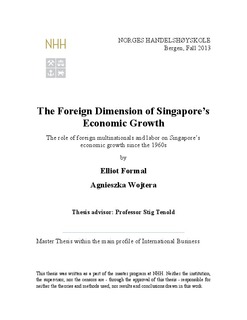The foreign dimension of Singapore’s economic growth : the role of foreign multinationals and labor on Singapore’s economic growth since the 1960s
Master thesis
Permanent lenke
http://hdl.handle.net/11250/217096Utgivelsesdato
2013Metadata
Vis full innførselSamlinger
- Master Thesis [4372]
Sammendrag
Singapore’s growth from its independence in 1965 to present day is truly remarkable.
Much of the country’s economic success is due to the policies and strategies implemented
by the Singaporean government and its agency the Economic Development Board (EDB).
These include active promotion and targeting of foreign multinationals (MNCs) to invest
in the country, a dynamic sectoral allocation of industries, and a shrewd use of both
skilled and unskilled foreign labor.
As foreign investment into Singapore has increased throughout the years, so have the
amount of foreign laborers in Singapore. The government has always had an open-door
policy for foreign skilled workers aiding Singapore to achieve its goals of
industrialization and subsequent upgrading. With economic growth, the need for lowskilled
foreign workers also emerged to maintain the country’s competitiveness. These
workers would help to keep wages low, fill in labor shortages, and do menial jobs that
Singaporeans would increasingly refuse to do.
The aim of this paper is to show how foreign MNCs, skilled labor, and unskilled labor
have intertwined in Singapore’s growth story, and the extent to which this foreign
dimension has contributed to the story. The story begins in the early 1960s when
Singapore first made the push for foreign MNC operations to invest in Singapore, but the
authors’ analysis will mostly focus on the period post-1980 where data is more available
on foreign MNCs and labor.
